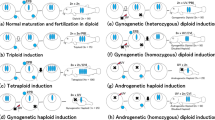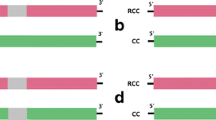Abstract
Wild-type dojo loach (Misgurnus anguillicaudatus) commonly reproduces bisexually as a gonochoristic diploid (2n = 50), but gynogenetically reproducing clonal diploid lines (2n = 50) exist in certain districts in Japan. Clones have been considered to develop from past hybridization event(s) between two genetically diverse groups, A and B, within the species. Fluorescence in situ hybridization analyses using the repetitive sequence “ManDra” as a probe clearly distinguished 25 chromosomes derived from group B out of a total of 50 diploid chromosomes of the clone, providing strong molecular cytogenetic evidence of its hybrid origin. In meiosis, diploid wild-type showed 25 bivalents, while diploid clones revealed 50 bivalents, indicating the presence of 100 chromosomes. In meiotic chromosome spreads in sex-reversed clonal males, ManDra signals were detected in 25 out of 50 bivalents, and only one out of two bivalents possessing major ribosomal RNA coding regions exhibited two positive ManDra signals. In clonal females, ManDra signals were detected in approximately 25 out of 50 bivalents. Thus, unreduced gametes should be generated by the pairing between sister chromosomes doubled from each ancestral chromosome from the different groups by premeiotic endomitosis. Sister chromosome pairing should assure production of unreduced isogenic clonal gametes due to the absence of the influence of recombination or crossing over.





Similar content being viewed by others
Abbreviations
- DAPI:
-
4′, 6-Diamidino-2-phenylindole, dihydrochloride
- FISH:
-
Fluorescence in situ hybridization
- GISH:
-
Genomic in situ hybridization
- GV:
-
Germinal vesicle
- IRBP2 :
-
Interphotoreceptor retinoid binding protein 2
- mtDNA-CR:
-
Mitochondrial DNA control region
- NORs:
-
Nucleolar organizing regions
- RAG1 :
-
Recombination activating gene 1
- rDNA:
-
Ribosomal DNA
- SSC:
-
Saline sodium citrate buffer
- tRNA:
-
Transfer RNA
References
Arai K, Fujimoto T (2013) Genomic constitution and atypical reproduction in polyploid and unisexual lineages of the Misgurnus loach, a teleost fish. Cytogenet Genome Res 140(2–4):226–240. https://doi.org/10.1159/000353301
Arai K, Mukaino M (1997) Clonal nature of gynogenetically induced progeny of triploid (diploid × tetraploid) loach, Misgurnus anguillicaudatus (Pisces: Cobitididae). J Exp Zool 278(6):412–421. https://doi.org/10.1002/(SICI)1097-010X(19970815)278:6<412::AID-JEZ9>3.0.CO;2-R
Arias-Rodriguez L, Morishima K, Arai K (2007) Genetically diversified populations in the loach Misgurnus anguillicaudatus inferred from newly developed microsatellite markers. Mol Ecol Notes 7(1):82–85. https://doi.org/10.1111/j.1471-8286.2006.01536.x
Arias-Rodriguez L, Yasui GS, Arai K (2009) Disruption of normal meiosis in artificial inter-populational hybrid females of Misgurnus loach. Genetica 136(1):49–56. https://doi.org/10.1007/s10709-008-9299-x
Beukeboom LW, Vrijenhoek RC (1998) Evolutionary genetics and ecology of sperm-dependent parthenogenesis. J Evol Biol 11(6):755–782
Bi K, Bogart JP (2006) Identification of intergenomic recombinations in unisexual salamanders of the genus Ambystoma by genomic in situ hybridization (GISH). Cytogenet Genome Res 112(3–4):307–312. https://doi.org/10.1159/000089885
Cherfas NB (1966) Natural triploidy in females of the unisexual form of silver crucian carp (Carassius auratus gibelio Bloch). Genetika 5:16–24
Cherfas NB, Gomelsky BI, Emelyanova OV, Recoubratsky AV (1994) Induced diploid gynogenesis and polyploidy in crucian carp, Carassius auratus gibelio (Bloch), × common carp, Cyprinus carpio L., hybrids. Aquac Res 25(9):943–954. https://doi.org/10.1111/j.1365-2109.1994.tb01356.x
Chevassus B (1983) Hybridization in fish. Aquaculture 33(1):245–262. https://doi.org/10.1016/0044-8486(83)90405-2
Choleva L, Janko K, Gelas KD et al (2012) Synthesis of clonality and polyploidy in vertebrate animals by hybridization between two sexual species. Evolution 66(7):2191–2203. https://doi.org/10.1111/j.1558-5646.2012.01589.x
Collares-Pereira MJ, Matos I, Morgado-Santos M, Coelho MM (2013) Natural pathways towards polyploidy in animals: the Squalius alburnoides fish complex as a model system to study genome size and genome reorganization in polyploids. Cytogenet Genome Res 140(2–4):97–116. https://doi.org/10.1159/000351729
Dawley RM (1987) Hybridization and polyploidy in a community of three sunfish species (Pisces: Centrarchidae). Copeia 1987(2):326–335. https://doi.org/10.2307/1445768
Dawley RM (1989) An introduction to unisexual vertebrates. In: Dawley RM, Bogart JP (eds) Evolution and ecology of unisexual vertebrates. New York State Museum, Albany, New York, pp 1–18
Fujimoto T, Yamada A, Kodo Y, Nakaya K, Okubo-Murata M, Saito T, Ninomiya K, Inaba M, Kuroda M, Arai K, Murakami M (2017) Development of nuclear DNA markers to characterize genetically diverse groups of Misgurnus anguillicaudatus and its closely related species. Fish Sci 83(5):743–756. https://doi.org/10.1007/s12562-017-1108-y
Fujiwara A, Abe S, Yamaha E, Yamazaki F, Yoshida CM (1998) Chromosomal localization and heterochromatin association of ribosomal RNA gene loci and silver-stained nucleolar organizer regions in salmonid fishes. Chromosom Res 6(6):463–471. https://doi.org/10.1023/A:1009200428369
Goddard KA, Dawley RM (1990) Clonal inheritance of a diploid nuclear genome by a hybrid freshwater minnow (Phoxinus eos-neogaeus, Pisces:Cyprinidae). Evolution 44(4):1052–1065. https://doi.org/10.1111/j.1558-5646.1990.tb03825.x
Goddard KA, Megwinoff O, Wessner LL, Giaimo F (1998) Confirmation of gynogenesis in Phoxinus eos-neogaeus (Pisces:Cyprinidae). J Hered 89(2):151–157. https://doi.org/10.1093/jhered/89.2.151
Islam FB, Ishishita S, Uno Y, Mollah MBR, Srikulnath K, Matsuda Y (2013) Male hybrid sterility in the mule duck is associated with meiotic arrest in primary spermatocytes. Journal of Poultry Science 50(4):311–320. https://doi.org/10.2141/jpsa.0130011
Itono M, Morishima K, Fujimoto T, Bando E, Yamaha E, Arai K (2006) Premeiotic endomitosis produces diploid eggs in the natural clone loach, Misgurnus anguillicaudatus (Teleostei: Cobitidae). J Exp Zool A Comp Exp Biol 305(6):513–523. https://doi.org/10.1002/jez.a.283
Itono M, Okabayashi N, Morishima K, Fujimoto T, Yoshikawa H, Yamaha E, Arai K (2007) Cytological mechanisms of gynogenesis and sperm incorporation in unreduced diploid eggs of the clonal loach, Misgurnus anguillicaudatus (Teleostei: Cobitidae). J Exp Zool A Comp Exp Biol 307(1):35–50. https://doi.org/10.1002/jez.a.344
Janko K, Bohlen J, Lamatsch D, Flajšhans M, Epplen JT, Ráb P, Kotlík P, Šlechtová V (2007) The gynogenetic reproduction of diploid and triploid hybrid spined loaches (Cobitis:Teleostei), and their ability to establish successful clonal lineages—on the evolution of polyploidy in asexual vertebrates. Genetica 131(2):185–194. https://doi.org/10.1007/s10709-006-9130-5
Johnson KR, Wright JE (1986) Female brown trout × Atlantic salmon hybrids produce gynogens and triploids when backcrossed to male Atlantic salmon. Aquaculture 57(1):345–358. https://doi.org/10.1016/0044-8486(86)90213-9
Khan MR, Arai K (2000) Allozyme variation and genetic differentiation in the loach Misgurnus anguillicaudatus. Fish Sci 66(2):211–222. https://doi.org/10.1046/j.1444-2906.2000.00037.x
Knytl M, Kalous L, Symonová R, Rylková K, Ráb P (2013) Chromosome studies of European cyprinid fishes: cross-species painting reveals natural allotetraploid origin of a Carassius female with 206 chromosomes. Cytogenet Genome Res 139(4):276–283. https://doi.org/10.1159/000350689
Kobel HR, Du Pasquier L (1975) Production of large clones of histocompatible, fully identical clawed toads (Xenopus). Immunogenetics 2:87–91. https://doi.org/10.1007/BF01572278
Kobel HR, Du Pasquier L (1979) Hyperdiploid species hybrids for gene mapping in Xenopus. Nature 279:157–158. https://doi.org/10.1038/279157a0
Lamatsch DK, Stöck M (2009) Sperm-dependent parthenogenesis and hybridogenesis in teleost fishes. In: Schön I, Martens K, Dijk P (eds) Lost sex: the evolutionary biology of parthenogenesis. Springer, Dordrecht, pp 399–432
Li YJ, Tian Y, Zhang MZ, Tian PP, Yu Z, Abe S, Arai K (2010) Chromosome banding and FISH with rDNA probe in the diploid and tetraploid loach Misgurnus anguillicaudatus. Ichthyol Res 57(4):358–366. https://doi.org/10.1007/s10228-010-0168-0
Li YJ, Yu Z, Zhang MZ, Qian C, Abe S, Arai K (2011) The origin of natural tetraploid loach Misgurnus anguillicaudatus (Teleostei: Cobitidae) inferred from meiotic chromosome configurations. Genetica 139(6):805–811. https://doi.org/10.1007/s10709-011-9585-x
Li YJ, Yu Z, Zhang MZ, Qian C, Abe S, Arai K (2012) Induction of viable gynogenetic progeny using eggs and UV-irradiated sperm from the Chinese tetraploid loach, Misgurnus anguillicaudatus. Aquac Int 21(4):759–768. https://doi.org/10.1007/s10499-012-9551-3
Li YJ, Gao YC, Zhou H, Ma HY, Li JQ, Arai K (2015) Meiotic chromosome configurations in triploid progeny from reciprocal crosses between wild-type diploid and natural tetraploid loach Misgurnus anguillicaudatus in China. Genetica 143(5):555–562. https://doi.org/10.1007/s10709-015-9853-2
Li YJ, Gao YC, Zhou H, Ma HY, Lin ZQ, Ma TY, Sui Y, Arai K (2016) Aneuploid progenies of triploid hybrids between diploid and tetraploid loach Misgurnus anguillicaudatus in China. Genetica 144(5):601–609. https://doi.org/10.1007/s10709-016-9928-8
Liu S, Liu Y, Zhou G, Zhang X, Luo C, Feng H, He X, Zhu G, Yang H (2001) The formation of tetraploid stocks of red crucian carp × common carp hybrids as an effect of interspecific hybridization. Aquaculture 192(2):171–186. https://doi.org/10.1016/S0044-8486(00)00451-8
Lutes AA, Neaves WB, Baumann DP, Wiegraebe W, Baumann P (2010) Sister chromosome pairing maintains heterozygosity in parthenogenetic lizards. Nature 464:283–286. https://doi.org/10.1038/nature08818
Majtanova Z, Choleva L, Symonová R et al (2016) Asexual reproduction does dot apparently increase the rate of chromosomal evolution: karyotype stability in diploid and triploid clonal hybrid fish (Cobitis, Cypriniformes, Teleostei). PLoS One 11(1):e0146872. https://doi.org/10.1371/journal.pone.0146872
Morishima K, Horie S, Yamaha E, Arai K (2002) A cryptic clonal line of the loach Misgurnus anguillicaudatus (Teleostei: Cobitidae) evidenced by induced gynogenesis, interspecific hybridization, microsatellite genotyping and multilocus DNA fingerprinting. Zool Sci 19(5):565–575. https://doi.org/10.2108/zsj.19.565
Morishima K, Nakamura-Shiokawa Y, Bando E, Li YJ, Boroń A, Khan MMR, Arai K (2008) Cryptic clonal lineages and genetic diversity in the loach Misgurnus anguillicaudatus (Teleostei: Cobitidae) inferred from nuclear and mitochondrial DNA analyses. Genetica 132(2):159–171. https://doi.org/10.1007/s10709-007-9158-1
Morishima K, Yoshikawa H, Arai K (2012) Diploid clone produces unreduced diploid gametes but tetraploid clone generates reduced diploid gametes in the Misgurnus loach. Biol Reprod 86(2):1–8. https://doi.org/10.1095/biolreprod.111.093302
Moritz C, Brown WM, Densmore LD et al (1989) Genetic diversity and the dynamics of hybrid parthenogenesis in Cnemidophorus (Teiidae) and Heteronotia (Gekkonidae). In: Dawley RM, Bogart JP (eds) Evolution and ecology of unisexual vertebrates. New York State Museum, Albany, New York, pp 87–112
Ogielska M (2009) Development and reproduction of amphibian species, hybrids, and polyploids. In: Ogielska M (ed) Reproduction of amphibians. Science Publishers, New Hampshire, pp 343–410
Rampin M, Bi K, Bogart JP, Collares-Pereira MJ (2012) Identifying parental chromosomes and genomic rearrangements in animal hybrid complexes of species with small genome size using genomic in situ hybridization (GISH). Comp Cytogenet 6(3):287–300. https://doi.org/10.3897/CompCytogen.v6i3.3543
Schultz RJ (1967) Gynogenesis and triploidy in the viviparous fish Poeciliopsis. Science 157(3796):1564–1567. https://doi.org/10.1126/science.157.3796.1564
Schultz RJ (1969) Hybridization, unisexuality, and polyploidy in the teleost Poeciliopsis (Poeciliidae) and other vertebrates. Am Nat 103(934):605–619. https://doi.org/10.1086/282629
Shimizu Y, Shibata N, Sakaizumi M, Yamashita M (2000) Production of diploid eggs through premeiotic endomitosis in the hybrid medaka between Oryzias latipes and O. curvinotus. Zool Sci 17(7):951–958. https://doi.org/10.2108/zsj.17.951
Vrijenhoek RC (1994) Unisexual fish: model systems for studying ecology and evolution. Annu Rev Ecol Syst 25(1):71–96
Yamada A, Kodo Y, Murakami M, Kuroda M, Aoki T, Fujimoto T, Arai K (2015) Hybrid origin of gynogenetic clones and the introgression of their mitochondrial genome into sexual diploids through meiotic hybridogenesis in the loach, Misgurnus anguillicuadatus. J Exp Zool A Ecol Genet Physiol 323(9):593–606. https://doi.org/10.1002/jez.1950
Yamashita M, Jiang J, Onozato H, Nakanishi T, Nagahama Y (1993) A tripolar spindle formed at meiosis I assures the retention of the original ploidy in the gynogenetic triploid crucian carp, ginbuna Carassius auratus langsdorfii. Develop Growth Differ 35(6):631–636. https://doi.org/10.1111/j.1440-169X.1993.00631.x
Yoshikawa H, Morishima K, Kusuda S, Yamaha E, Arai K (2007) Diploid sperm produced by artificially sex-reversed clone loaches. J Exp Zool A Ecol Genet Physiol 307(2):75–83. https://doi.org/10.1002/jez.a.337
Yoshikawa H, Morishima K, Fujimoto T, Saito T, Kobayashi T, Yamaha E, Arai K (2009) Chromosome doubling in early spermatogonia produces diploid spermatozoa in a natural clonal fish. Biol Reprod 80(5):973–979. https://doi.org/10.1095/biolreprod.108.075150
Zalesna A, Choleva L, Ogielska M, Rábová M, Marec F, Ráb P (2011) Evidence for integrity of parental genomes in the diploid hybridogenetic water frog Pelophylax esculentus by genomic in situ hybridization. Cytogenet Genome Res 134(3):206–212. https://doi.org/10.1159/000327716
Zhang Q, Arai K, Yamashita M (1998) Cytogenetic mechanisms for triploid and haploid egg formation in the triploid loach Misgurnus anguillicaudatus. J Exp Zool 281(6):608–619. https://doi.org/10.1002/(SICI)1097-010X(19980815)281:6<608::AID-JEZ9>3.0.CO;2-R
Acknowledgments
We thank Dr. Atsushi Fujiwara (National Research Institute of Fisheries Science, Japan Fisheries Research and Education Agency) for technical advice. This study was supported by Grants-in-Aid from JSPS (Japan Society for the Promotion of Science) KAKENHI Grant Number 15H02457 and JSPS Research Fellow Number 17J01971.
Author information
Authors and Affiliations
Corresponding author
Ethics declarations
Conflict of interest
The authors declare that they have no conflict of interest.
Informed consent
Informed consent was obtained from all individual participants included in the study.
Ethical approval
This study was performed according to the Guide for the Care and Use of Laboratory Animals at Hokkaido University. All animal experiments were approved by the animal study ethical committee of Hokkaido University (approval number 19-2).
Additional information
Responsible Editor: Tatsuo Fukagawa
Rights and permissions
About this article
Cite this article
Kuroda, M., Fujimoto, T., Murakami, M. et al. Clonal reproduction assured by sister chromosome pairing in dojo loach, a teleost fish. Chromosome Res 26, 243–253 (2018). https://doi.org/10.1007/s10577-018-9581-4
Received:
Revised:
Accepted:
Published:
Issue Date:
DOI: https://doi.org/10.1007/s10577-018-9581-4




